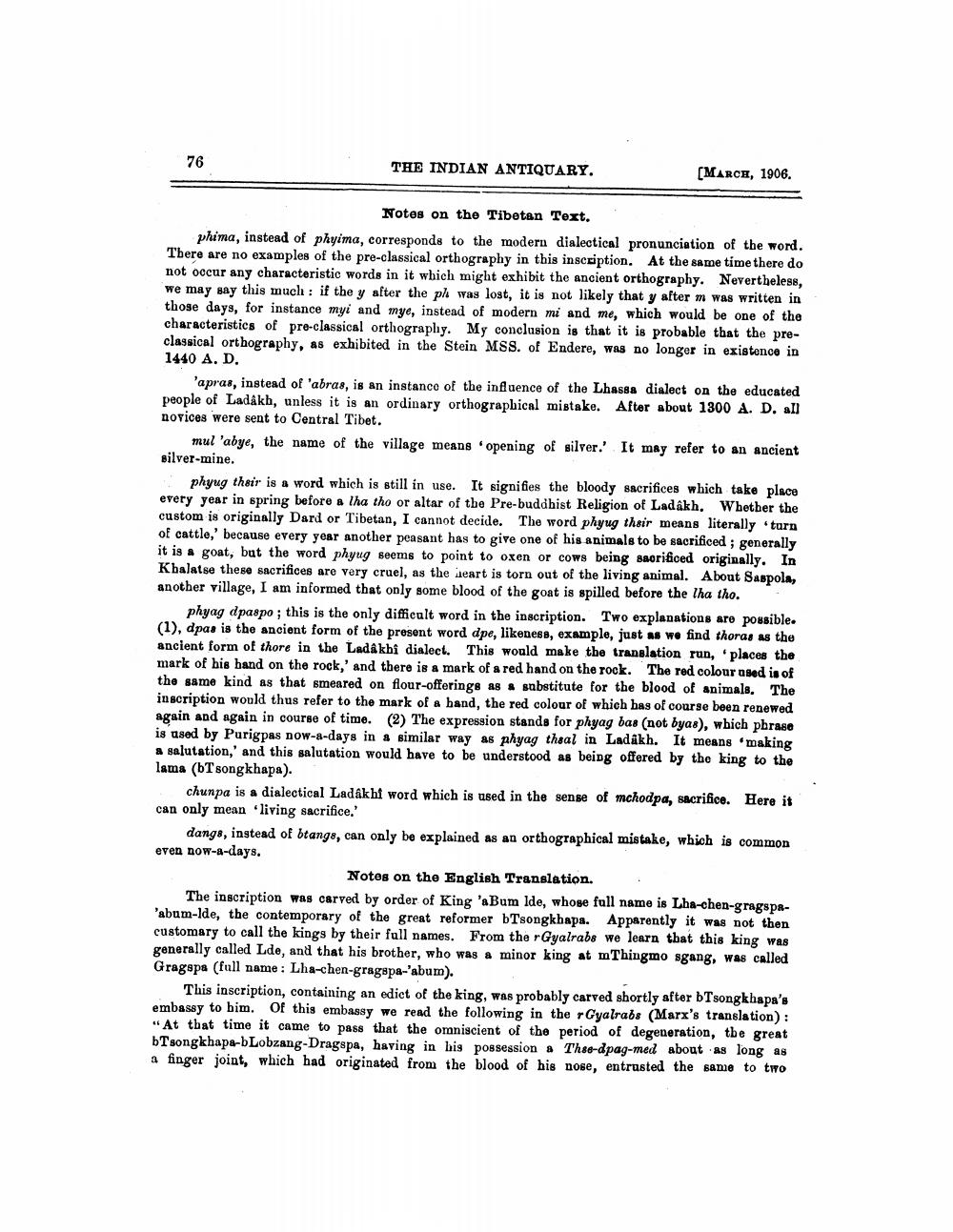________________
76
THE INDIAN ANTIQUARY.
[MARCH, 1906.
Notes on the Tibetan Text.
phima, instead of phyima, corresponds to the modern dialectical pronunciation of the word. There are no examples of the pre-classical orthography in this inscription. At the same time there do not occur any characteristic words in it which might exhibit the ancient orthography. Nevertheless, we may say this much: if the y after the ph was lost, it is not likely that y after m was written in those days, for instance myi and mye, instead of modern mi and me, which would be one of the characteristics of pre-classical orthography. My conclusion is that it is probable that the preclassical orthography, as exhibited in the Stein MSS. of Endere, was no longer in existence in 1440 A. D.
'apras, instead of 'abras, is an instance of the influence of the Lhassa dialect on the educated people of Ladakh, unless it is an ordinary orthographical mistake. After about 1300 A. D. all novices were sent to Central Tibet.
mul 'abye, the name of the village means opening of silver.' It may refer to an ancient silver-mine.
phyug their is a word which is still in use. It signifies the bloody sacrifices which take place every year in spring before a lha tho or altar of the Pre-buddhist Religion of Ladakh. Whether the custom is originally Dard or Tibetan, I cannot decide. The word phyug their means literally turn of cattle,' because every year another peasant has to give one of his animals to be sacrificed; generally it is a goat, but the word phyug seems to point to oxen or cows being sacrificed originally. In Khalatse these sacrifices are very cruel, as the heart is torn out of the living animal. About Saspola, another village, I am informed that only some blood of the goat is spilled before the tha tho.
phyag dpaspo; this is the only difficult word in the inscription. Two explanations are possible. (1), dpas is the ancient form of the present word dpe, likeness, example, just as we find thoras as the ancient form of thore in the Ladakhî dialect. This would make the translation run, 'places the mark of his hand on the rock,' and there is a mark of a red hand on the rock. The red colour used is of the same kind as that smeared on flour-offerings as a substitute for the blood of animals. The inscription would thus refer to the mark of a hand, the red colour of which has of course been renewed again and again in course of time. (2) The expression stands for phyag bas (not byas), which phrase is used by Purigpas now-a-days in a similar way as phyag theal in Ladakh. It means 'making a salutation,' and this salutation would have to be understood as being offered by the king to the lama (bTsongkhapa).
chunpa is a dialectical Ladakhi word which is used in the sense of mchodpa, sacrifice. Here it can only mean 'living sacrifice.'
dangs, instead of btangs, can only be explained as an orthographical mistake, which is common even now-a-days.
Notes on the English Translation.
The inscription was carved by order of King 'aBum lde, whose full name is Lha-chen-gragspa'abum-lde, the contemporary of the great reformer bTsongkhapa. Apparently it was not then customary to call the kings by their full names. From the rGyalrabs we learn that this king was generally called Lde, and that his brother, who was a minor king at mThingmo sgang, was called Gragspa (full name: Lha-chen-gragspa-'abum).
This inscription, containing an edict of the king, was probably carved shortly after bTsongkhapa's embassy to him. Of this embassy we read the following in the rGyalrabs (Marx's translation): "At that time it came to pass that the omniscient of the period of degeneration, the great bTsongkhapa-bLobzang-Dragspa, having in his possession a Thee-dpag-med about as long as a finger joint, which had originated from the blood of his nose, entrusted the same to two




